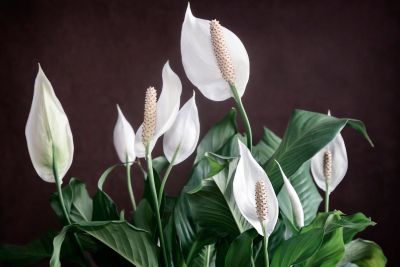Choosing Low Light Flowering Houseplants
Low light indoor plants are an excellent way to add greenery, but what about color? A low light indoor plant with flowers is harder to come by, but not impossible. Here are some great choices for houseplants that bloom with little light:
African Violets – These are among the best flowers for low light indoors. African violets can bloom almost continually year round if they are kept happy. You can get these to bloom even in areas with no direct sunlight. In fact, they prefer bright indirect light, or filtered sun, for best results. These plants prefer warmer conditions (over 65 F. or 18 C.) and like the surface of their soil to dry out before watering again. Fertilize regularly for best results. Lipstick Plants – A more unusual flowering plant to grow indoors is the lipstick plant. The care is very similar to African violets, but these are trailing plants. In fact, African violets and lipstick plants are related. The plant produces numerous red flowers with maroon bases that resemble lipstick tubes. Streptocarpus – Another beautiful flowering plant also related to African violets is cape primrose (Streptocarpus). The care is similar but they look quite different. They can bloom just as prolifically, though, in many colors. Just make sure to keep the soil relatively moist and keep them in good indirect light for best results. Peace Lily – Peace lily (Spathiphyllum) is among the best of houseplants that blooms with little light. The spathes are typically white and can show up throughout the year, but will probably be more plentiful in the summer time – and with a little more light. The glossy, large leaves offer a beautiful backdrop against the white flowers. These plants like to be on the moist side so make sure not to let these dry out completely if you can help it. Phalaenopsis – Moth orchids are among the lowest light orchids that can be easily grown in the home. They thrive in average indoor conditions and the flowers can easily last a few months and are easy to rebloom. They are epiphytes in nature, so they are typically sold growing in a bark mix or sphagnum moss. When you water, be sure to thoroughly moisten all the roots, including exposed roots. If you can help it, never let them dry out completely. Sufficient light is needed to trigger blooming. A 10- to 15-degree (5 to 8 C) drop in nighttime temperature can also help induce blooming. Bromeliads – The leaves and bracts of these low light indoor plants, also epiphytes, are vibrant and colorful, adding flair to any room or cubicle. Bromeliads may also produce lovely flowers, but in between, you can just enjoy their natural beauty. Christmas Cactus – Christmas cacti make good indoor plants and require little care. These plants need 12 hours of darkness to bloom, and this normally occurs during the winter months in most households. This is also why they are good low light indoor plants. The flowers on a Christmas cactus can range from white to pink to red.
Remember that low light does not mean a dark corner in your home or office. These plants still need a certain amount of bright indirect light to grow. If you find that your plant is not blooming, you are likely not giving it enough light. Either move your plant closer to a window or supplement with additional fluorescent lighting.
